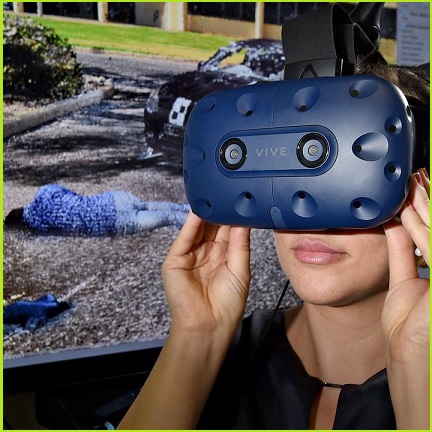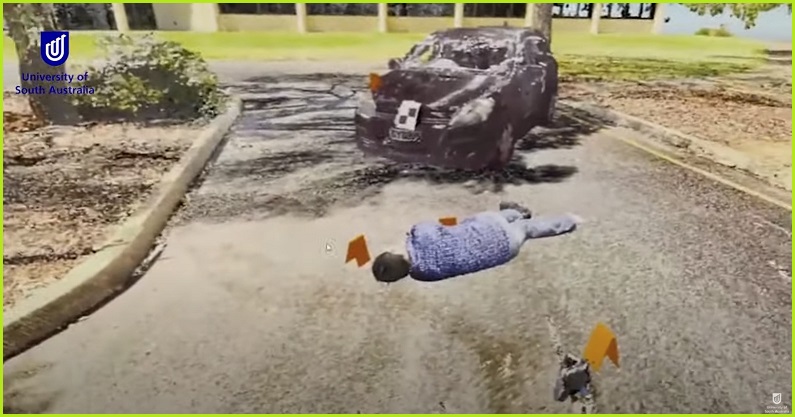Letting jurors ‘walk through’ crime scenes using virtual reality (VR) improves their spatial memory and makes it easier for them to agree on a verdict, according to new University of South Australia (UniSA) research that could pave the way for the technology to be introduced in courtrooms.
Lawyers traditionally use crime scene site visits or photographs to support their arguments to juries, who must decide whether the information meets the requirements of a particular criminal charge.
However, individual interpretations and poor memories of relevant details can fuel discord in the jury room – with jurors often struggling to reach a consensus.
Aiming to see whether VR could help jurors better understand the situation and elements of a case, a project team linked to the University of South Australia’s Data to Decisions Cooperative Research Centre (DtD CRC) – which has previously published research confirming the mnemonic value of 3D crime scene reconstructions – built a simulated crime scene in a nearby carpark and scanned it in 3D.
“Because virtual reality immerses you in the scene, and gives you so much more information, our motivating research question was whether we could build up a stronger mental model and get more consistent outcomes out of the jury members,” researcher Dr Andrew Cunningham, a UniSA lecturer in Agile methodology and information visualisation design, told Information Age.
Project participants who were shown photographs of the crime scene came to very different conclusions, with 47 per cent favouring a verdict of careless driving and 53 per cent arguing for dangerous driving.
Given their significantly different consequences – careless driving generally attracts a fine while dangerous driving involves mandatory licence suspension and potential imprisonment – the difference in verdicts is more than academic.
When given VR goggles to wear, participants were able to walk around the 3D-scanned scene, jump to different vantage points and inspect elements such as the victim, car, the view from the driver’s seat, and the surrounds.
“We captured a fair bit of detail using the 3D scanning technology,” Cunningham said, “and by putting the headset on to see that capture in full 3D, they’re trying to bring in all these little bits of information and build up a story in their minds of what actually happened.”
“If we can immerse them in it, then we can potentially help them build up a stronger mental model.”
The results suggested that participants were indeed building a more complete and consistent mental image: asked about the verdict they would choose after using the VR headset, 87 per cent of the test subjects concluded the scene illustrated a Death by Dangerous Driving verdict.

VR headsets may assist jurors. Photo: University of South Australia
Virtual crime scenes, real courtrooms
For several years, police forces around the world have increasingly been using specialised 3D capture equipment from the likes of Trimble and Faro to scan crime scenes in great detail for later analysis.
NSW Police, for one, used the technology years ago to scan and map the inside of the Lindt Café and have been increasingly using 3D scanning to generate detailed captures of crime scenes.
The Australian Federal Police is also using the technology – which provides enough detail to compare footprints at crime scenes with footprints of persons of interest, and can help jurors closely examine evidence rendered in VR at millimetre resolution.
The digital nature of the crime-scene captures means that security and data integrity are crucial to avoid tampering; courts would also need to consider whether VR models could be adjusted to, for example, exclude evidence that is successfully challenged at trial.
Whatever procedures are adopted, such scans are likely to become even easier to generate, given that the LiDAR technology they rely on is being integrated into handheld devices such as Apple’s iPhone 12 and iPad Pro – as well as being built into drones that can map entire areas from the sky.
With so many scenes being captured in 3D, projecting them in virtual reality was a relatively straightforward task: the UniSA team used HTC Vive Pro VR goggles, wirelessly connected so that participants “could walk around freely in the space and weren’t tethered to a computer”, Cunningham said.
The 3D ‘point cloud’ scans were fed into the Unity 3D game engine and projected to the goggles, he added: “It wasn’t super complicated.”
The project is part of ongoing DtD CRC work to explore the use of new technologies in the judicial system, Cunningham said, with strong support from judges to whom the team members have demonstrated its use.
Judges “are really interested in new technologies and what the future looks like,” he explained, “and their basic takeaway was that this technology is coming – and it’s absolutely going to be introduced to the courtroom at some point in the future.”










